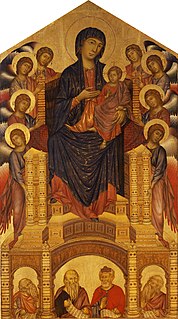
Cimabue, also known as Cenni di Pepo or Cenni di Pepi, was an Italian painter and designer of mosaics from Florence.

Duccio di Buoninsegna was an Italian painter active in Siena, Tuscany, in the late 13th and early 14th century. He was hired throughout his life to complete many important works in government and religious buildings around Italy. Duccio is considered one of the greatest Italian painters of the Middle Ages, and is credited with creating the painting styles of Trecento and the Sienese school. He also contributed significantly to the Sienese Gothic style.
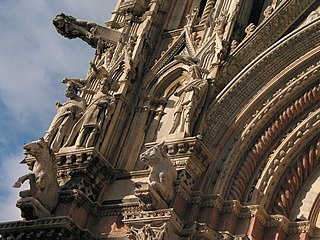
Giovanni Pisano was an Italian sculptor, painter and architect, who worked in the cities of Pisa, Siena and Pistoia. He is best known for his sculpture which shows the influence of both the French Gothic and the Ancient Roman art. Henry Moore, referring to his statues for the facade of Siena Cathedral, called him "the first modern sculptor".

Maestà[maeˈsta], the Italian word for "majesty", designates an iconic formula of the enthroned Madonna with the child Jesus, whether or not accompanied with angels and saints. The Maestà is an extension of the "Seat of Wisdom" theme of the seated "Mary Theotokos", "Mary Mother of God", which is a counterpart to the earlier icon of Christ in Majesty, the enthroned Christ that is familiar in Byzantine Mosaics. Maria Regina is an art historians' synonym for the iconic image of Mary enthroned, with or without the Child.

Saint Veridiana is an Italian saint.

Dietisalvi di Speme was an Italian painter, who worked in Siena between 1250 and 1291. In his work he influenced and was influenced by Cimabue.
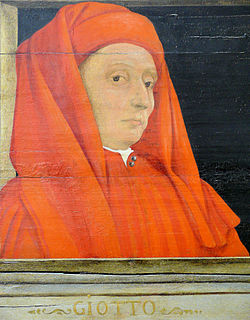
Giotto di Bondone, known mononymously as Giotto and Latinised as Giottus, was an Italian painter and architect from Florence during the Late Middle Ages. He worked during the Gothic/Proto-Renaissance period. Giotto's contemporary, the banker and chronicler Giovanni Villani, wrote that Giotto was "the most sovereign master of painting in his time, who drew all his figures and their postures according to nature" and of his publicly recognized "talent and excellence". In his Lives of the Most Excellent Painters, Sculptors, and Architects, Giorgio Vasari described Giotto as making a decisive break with the prevalent Byzantine style and as initiating "the great art of painting as we know it today, introducing the technique of drawing accurately from life, which had been neglected for more than two hundred years".

The Rucellai Madonna is a panel painting representing the Virgin and Child enthroned with Angels by the Sienese painter Duccio di Buoninsegna. The original contract for the work is dated 1285; the painting was probably delivered in 1286. The painting was commissioned by the Laudesi confraternity of Florence to decorate the chapel they maintained in the Dominican church of Santa Maria Novella. It was transferred to the Galleria degli Uffizi in the 19th century. The Rucellai Madonna is the largest 13th-century panel painting extant.

Cimabue's Celebrated Madonna, originally called Cimabue's [Celebrated] Madonna [is] Carried in Procession through the Streets of Florence, is an oil painting by English artist Frederic Leighton. Measuring more than two metres tall and more than five metres wide, the canvas was painted by Leighton from 1853 to 1855 in Rome as his first major work. Since 1988 it has been displayed in the National Gallery, London, on long-term loan from the Royal Collection, where it has been previously hung prominently, high above the main vestibule, directly beyond the entrance to the gallery.

Master of Città di Castello, in Italian, Maestro di Città di Castello, was an anonymous painter of Medieval art. Mason Perkins is responsible for his identification and naming in 1908, based on the styling from the Master preserved at the Pinacoteca comunale, Città di Castello, in Umbria.
The Arco delle Due Porte or Arch of Two Doors is one the remaining portals in the 11th century walls of Siena. It has been variously called the Porta di Stalloreggi with the gates known as San Quirico, Santa Margherita, and the Arco di Santa Lucia. It was the entrance into the southwesternmost end of Via Stalloreggi in Siena, region of Tuscany, Italy. Outside of the portal, in the Piazetta dell Due Porte are a confluence of streets: Via Fosso di Sant'Ansano flows south, Via Paolo Mascagni flows west, and Pian dei Mantellini flows south. Via Mascagni leads down the slope some 200 meters to the 13th-century gate: Porta Laterina. Pian dei Mantellini lead to the church and convent del Carmine.
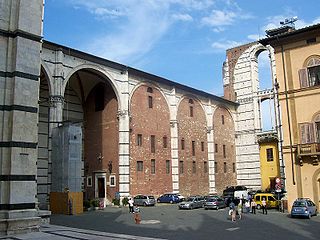
The Museo dell'Opera del Duomo is an art museum in Siena, in Tuscany in central Italy. It houses works of art and architectural fragments that were formerly in, or a part of, the Duomo of Siena. These include a number of Italian Gothic sculptures by Giovanni Pisano and his school from the façade of the cathedral; the Maestà of Duccio di Boninsegna, which was the altarpiece from about 1311 until 1505 or 1506; and works by Ambrogio and Pietro Lorenzetti. There are also works moved to the museum from other churches in the area, such as the Madonna of Duccio brought from the Pieve di Santa Cecilia at Crevole in the comune of Murlo.
Blessed Jacopone da Todi is a fragment of a fresco by Paolo Uccello, dating to early in 1436. It shows the Franciscan Jacopone da Todi and was originally located to the right of the altar in the Cappella dell'Assunta in Prato Cathedral. In 1967 it was moved to the Museo dell'Opera del Duomo and at the end of the 1990s it was moved to the Museo Civico, where it is displayed in the "I Tesori della città" gallery.

The Master of the Bigallo Crucifix (fl.1215/20-1265) was an Italian religious artist who ran one of the first fully organized workshops before Cimabue. His notname comes from a crucifix on wood which is displayed at the Museo del Bigallo in Florence.

The Crucifixion is a painting in tempera and gold on panel of c. 1315 attributed to Giotto, now in the Musée des Beaux-Arts of Strasbourg, France. Its inventory number is 167.

The Maestà of Santa Maria dei Servi is a tempera and gold on panel painting by Cimabue or his workshop, dating to c.1280-1285, between his Louvre Maestà (c.1280) on the one hand and the Assisi frescoes (1288-1292) and the Santa Trinita Maestà (c.1290-1300) on the other. It is named after the church of Santa Maria dei Servi in Bologna, where it hangs.
Luciano Bellosi was an Italian art historian.
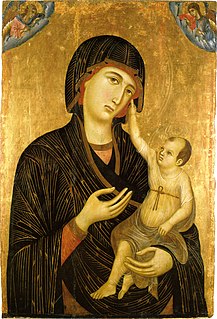
The Crevole Madonna is a tempera and gold on wood panel painting by Duccio di Buoninsegna, created c. 1283-1284. It was originally in the Pieve di Santa Cecilia in Crevole and now its held in the Museo dell'Opera metropolitana del Duomo in Siena. It was one of the artist's first works.
The Life of Christ is a series of five paintings in tempera and gold on panel depicting scenes from the Life of Christ and the Last Judgement. The works date to around 1290–1300 and are attributed to the circle of Cimabue or to a Venetian artist. They are now in various museums and private collections: the Longhi Foundation in Florence, the New Orleans Museum of Art, the Portland Art Museum, the Pedralbes Monastery near Barcelona and a private collection in Milan.















